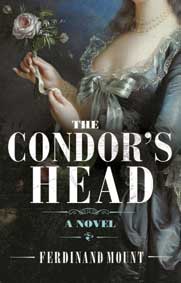 Everything looks set for him to have a glorious career as he sets off for pre-Revolutionary France in the capacity of Jefferson’s private secretary. That is, until he stumbles across something that the Old World can furnish but that the New World is strangely lacking – the mystery of love.
Everything looks set for him to have a glorious career as he sets off for pre-Revolutionary France in the capacity of Jefferson’s private secretary. That is, until he stumbles across something that the Old World can furnish but that the New World is strangely lacking – the mystery of love.
Ferdinand Mount’s novel is filled with the most wonderfully witty sentences, sometimes long and looping with a dry joke tucked in at the end, sometimes short and laconic. His Paris is roisterous, riotous: a place where a man, on visiting a brothel, can find himself whisked away by a depraved aristocrat to an estate where satyrs bound and orgies take place in Chinese pavilions – providing a highly amusing scene in which Wm. cannot prevent himself from thrusting in time with his host. In the salons and chateaux, Ducs resemble elevated schoolmasters, plump princesses rhapsodise about the food, and Louis XVI looks like a grocer. As for the famous Marie Antoinette: “at the Phi Beta Kappa ball her dance card would have been damn near blank.”
Wm. is a sensual man, but does not let his pleasures detract from his business: whilst Jefferson trails off around France on bizarre expeditions, it is Wm. who deals with the vast loans from Dutch bankers that keep America afloat, issues visas and does all the nitty-gritty of diplomacy. Behind it all lurks the menacing figure of the Marquise de Condorcet – the Condor’s head of the title – pulling strings and working against the King, advocating his Enlightenment ideals before eventually being destroyed by what he sets in motion.
A bust of Condorcet is the linch-pin of the plot. It arrives in Virginia at the beginning, with Wm. an old man; it is only at the end that we learn who sent it – the pretty, vivacious, charming Madame de la Rochefoucauld. It is the affair with her that almost ruins Wm.’s career, possibly causing Jefferson to overlook his promotion to Ambassador in Paris. Their love is initially platonic, but Wm. wants more; in a subtle scene, they read Rousseau together in a forest and when Wm. hints at adultery, the Duchesse breaks off relations entirely.
But not for long. Soon we are up and running again, careering through more (slightly wearying) break-ups and reconciliations.Throughout, the rumblings of revolution are conveyed with vivid touches: a sense of displacement, horror and betrayal at every corner.
Philip Womack works at Literary Review. The Condor's Head is published by Chatto & Windus

